#anime analysis
Text
one thing i really like about the apothecary diaries is how fluidly maomao moves between high- and low-class society, between the rear palace and the pleasure district, allowing us to see the parallels in the power dynamics. in both settings, we see women trying to make the most of their relative stations with whatever tools available to them, which are often shared. much of the politics of the series centers women and the ways they try to navigate the world through seduction, marriage, beauty, fashion, manipulation, etc, because these are the things they're valued for. their appearance, their social graces, their "purity", their marriageability, their ability to bear children, and beyond - these all lend political, economic, and social leverage to themselves and their families regardless of class.
the mystery angle in particular enables the story to closely examine what tools and motives are available to women in the apothecary diaries in a way that's contextualized and humanized. it's also how the series highlights said women operating with a keen awareness of society's expectations and systems. whether that's applying deathly white powder to maintain impractical beauty standards, faking illnesses to deter certain visitors, using parlor tricks to subtly punish callous men, or wearing ostentatious outfits to hide a certain truth, each mystery we encounter reveals more about what it means to navigate the world of the apothecary diaries as a woman in addition to revealing their cleverness (or lack thereof) in doing so.
maomao is no exception to the rule, often weighing similar questions of propriety and power before she acts - although she does engage from a unique position. she's a literate woman from the lower class with special circumstances surrounding her birth, versed as an apothecary, and favored by highly ranked members of the court. this, plus her marked lack of ambition beyond medicine, gives her a lot of mobility between and (relatively) unbiased insight into both the high- and low-ranked parts of society. in turn, we readers are given a fantastic protagonist to explore what i consider a core draw of the series: seeing how maomao chooses to move through the world, highly conscious of her own social positioning as well as that of all the other women around her
#the apothecary diaries#kusuriya no hitorigoto#maomao#my jessays#anime analysis#there's extremely light hints at content beyond the anime and even manga but i tried to be careful#kusuriya analysis#idr how to tag this for myself lmao i think tad stinks as an acronym frankly#anyway i love how much women are centered in the apothecary diaries it's truly delightful and i love seeing maomao connect with other women
1K notes
·
View notes
Text
if you take out all the murder, the ending of assassination classroom is reflected in any student-teacher bond. no matter how close they become, there is always a ticking clock on the relationship. you only get one year with that teacher, with that class. the end of the year may as well be the end of the world. everything the students learn brings them closer to the point when they can leave the teacher behind. after graduation, the students will move on to their futures, armed with all the knowledge they've gained, but the teacher can't come with them.
there's a reason every episode's title has the word "time" in it. because the whole show is about the time class e gets to spend together, and the titles are a constant reminder that that time is limited.
the assassination of koro-sensei is class e's graduation. from that moment forward, the teacher, the class, and middle school itself, are no longer a part of their lives. it would seem the message is that nothing lasts forever. the sakura blossoms always fall, children always grow up, and the fun times always end.
#assassination classroom#anime#manga#anime analysis#meta analysis#meta#nostalgia#endings#koro sensei#school#childhood
531 notes
·
View notes
Text
I don't ship Zutara that much but M*!k0 shippers who call it "colonizer x colonized" actually annoy me so badly 💀they literally undermine Zuko's whole ass arc and growth just bc they dislike Zutara then reduce him to some idiot colonizer as if he never had literally the best growth in the series. His whole arc is about NOT BECOMING a colonizer. How tf are you going to say that just bc you dislike Zutara when his whole arc is about becoming the opposite of a colonizer and even getting full on episodes of him getting Katara's forgiveness. You're literally taking away all of Zuko's growth, suffering, and development. 💀M*!k0 shippers are actually so dumb like why are you even defending that badly written ship lmao
#anti maiko#maiko anti#zuko x mai anti#zutara#analysis#anime#anime analysis#my meta#meta#atla meta#avatar#atla#avatar the last airbender#media literacy#avatar aang#zuko#katara#pro zuko#pro katara#prince zuko#not a big zutara person but seeing maiko shippers call zuko a colonizer just to upscale maiko literally baffles me like are you illiterate
148 notes
·
View notes
Text
So after reading this thread by @mydetheturk and @shastafirecracker, I got to thinking about Vash as a gun in Trigun Stampede. (I would have responded in thread, but the thread is Trigun Book Club and I'm about to get into spoilers for Stampede here. Which reminds me....)
Spoilers for Trigun Stampede Ahead
The series is called Trigun because Vash has three guns: 1) the one he carries, 2) the one in his prosthetic left arm, and 3) his angel arm. The thread linked above gets into how, throughout Trigun (every iteration, TBH), Vash doesn't simply wield weapons, but because of his angel arm he very literally is a weapon, and that's an identity he resists as much as he can. He doesn't want to be used for violence. He just wants to help people, but his very nature makes pursuing that path a rather difficult one.
In particular, once he's aware of its presence, Vash wants to take every precaution he can to stop from releasing the power that channels through his angel arm, which is understandable since it can literally level cities. That destructive power the antithesis of what Vash wants to be, but it's also an irremovable part of himself... and it's something that Knives covets enough to severely violate Vash in attempt to gain control of it. The power itself might be Vash's, but it's Knives who activates it, forces it into being, and thus compels Vash to both channel it into his angel arm and to pull the trigger on that insanely powerful gun.
However, in Stampede, it's not just the weight of the angel arm that Knives forces on Vash. Knives is literally responsible for Vash having the other two guns, as well.
These can both be traced to episode 9. First, Knives thrusts the handgun into Vash's arms, calling it, "An evil weapon of the Sinners, taking lives easily from afar with the twitch of a finger...."

Nominally, he's doing this to protect Vash. Vash won't raise his hand to take down the humans that literally just overclocked their sisters to death, to protect them or to protect himself, so Knives provides him with a weapon he labels a coward's tool for evil (gun #1). In doing that, he very much implies his brother is both a coward and someone who needs to embrace doing evil in order to survive.
It's only a few minutes later that Knives makes way for the second gun.
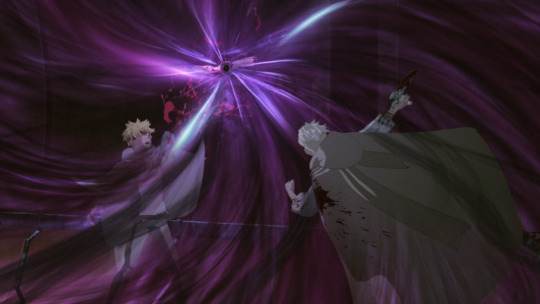
Knives slices off Vash's arm to protect him from the power Vash (accidentally) summoned to try to protect Luida from Knives, thus making way for Vash's prosthetic arm (gun #2).
Thus, every shot fired by Vash from either the handgun or the prosthetic is the result of Knives' actions, even when Knives isn't actively sending people to harass Vash.
"But wait," you hypothetically say. "In TriStamp, Vash's prosthetic arm has a grappling gun, not a gun that fires bullets."
You're right.
Interesting that the one gun Vash has the option to choose for himself in Stampede isn't designed for killing. Instead, Vash uses it to try and save himself, and to save Meryl.
(Though all things considered, I wouldn't be surprised if whatever upgrade he has in Season 2 is more in line with what fans of previous Trigun series are used to in his prosthetic arm.)
There's one other thing I'll note before wrapping this up. Going back to Episode 9 of Stampede... Vash is actually very quick to try and use that handgun Knives gives him. But he doesn't use it to defend himself from humans (or anyone else, really) the way Knives wants him to. Instead, he grits his teeth, does his best to steady an unsteady hand, and uses it to try and protect one of the only two humans left standing around them, Luida, from Knives.


#he is constantly CONSTANTLY resisting becoming just a tool for violence#especially a tool for violence against humanity#even when he has every reason to just give up and watch them burn#vash the stampede#millions knives#trigun stampede#anime analysis#pancake analysis
454 notes
·
View notes
Text
What was so heartbreaking about Suletta’s response to Miorine question of whether or not she’d really sacrifice her whole being if Prospera told her to is that its really obvious she’s forcing herself to rationalize this mindset of hers as the correct one. Even though deep down there’s a small, but very real seed of doubt.
When Miorine asks if Suletta would willingly give up her dream of creating a school for Mercury, her immediate response isn’t a yes. She becomes fidgety, awkwardly rubbing her fingers together and becoming more and more uncomfortable.


Whenever shes faced with some kind of internal crisis and needs immediate reassurance and mental stability from that crisis, Suletta will always go back to the mindset of “ Well if my mom says I should do this, then it must be right”
But when Miorine really presses her on whether she would actually use Gundams to kill people, she has this pained expression on her face
The thought clearly disturbs her, and internally there's conflict between what her mom is telling her she should do, and what her own moral compass is telling her what the right thing to do is.

But once again, in a response that seems very forced and not at all indiciative what she truly feels deep down, she escapes from her own inner turmoil by telling herself “ Its okay, moms always right.I was able to go to school and make so many friends, and meet Miss Miorine, all because of mom. So she has to be right. She has to be....
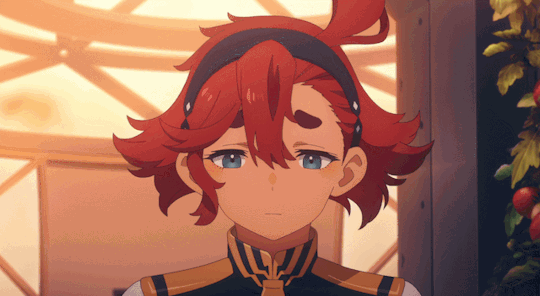
And once again, when she see’s just how horrified Miorine is with her response, shes left all alone with her thoughts. I feel like deep down she beginning to realize that the mindset of “move forwrad, gain two” isn’t working as well as it should. She’s inching closer at loser more and more of the things she values the more she moves forward. \

Her dreams.
Her friends.
Her future.
and Miorine.
#suletta mercury#g witch#sulemio#miorine rembran#gundam witch from mercury#mobile suit gundam#mobile suit gundam the witch from mercury#anime#anime analysis
708 notes
·
View notes
Text
Fullmetal Alchemist: Brotherhood breaks so many shounen stereotypes and I'm shook tbh. There're little to no flashbacks. There's no filler episodes. Almost none of the female characters are sexualized. All of the main characters, male and female, dress practically. The male mc doesn't have a six-pack. There isn't a beach/pool episode. The mc, Ed, breaks an entire plethora of mc-specific tropes all on his own. The relationship with the most primary focus isn't romantic, but familial. And there's probably a bunch more I haven't recognized yet.
#I haven't finished watching fmab so forgive me if there IS a beach episode#but honestly I don't think there will be one#there's too much plot stuff always happening#fma#fmab#fullmetal alchemist#fullmetal alchimist brotherhood#edward elric#fma edward#fma brotherhood#anime#anime analysis
1K notes
·
View notes
Text
A nonexistent human being. Or is he? (character analysis of Johan Liebert)
A few months ago I’ve read a book which was recommended by one of the Monster’s fans, - “The Divided Self” by Ronald David Laing. He suggested Laing’s work to everyone who’s confused about Johan’s mindset and motivations, just as I’m sure a lot of us were… It was a GREAT recommendation, so insightful that I wanted to share my thoughts and the interpretation I developed.
Any blockquote in this post is from “The Divided Self”, there will be too many to sign each of them, so just keep that in mind :)
It’s going to be a painfully long read, but hopefully a rewarding one too.
PART 1: DEFINITION OF ONTOLOGICAL INSECURITY, TRUE AND FALSE SELF
Firstly we need to get familiar with a few concepts from Laing’s work which will be important for understanding the rest of the essay. His book describes schizoids and schizophrenics, exploring the mechanisms behind their illness. But it is important to understand that he, although a psychiatrist, acknowledged mental illness primarily as an existential/philosophical problem rather than a purely medical one. He saw more value in understanding the patient's experience of the world rather than endlessly examining and manipulating their body.
The first term we will need is ontological insecurity. Let's compare how Laing describes someone who is confident in his own reality - and someone who is not.
The individual, then, may experience his own being as real, alive, whole; as differentiated from the rest of the world in ordinary circumstances so clearly that his identity and autonomy are never in question; as a continuum in time; as having an inner consistency, substantiality, genuineness, and worth; as spatially coextensive with the body; and, usually, as having begun in or around birth and liable to extinction with death. He thus has a firm core of ontological security.
<...>
The individual in the ordinary circumstances of living may feel more unreal than real; in a literal sense, more dead than alive; precariously differentiated from the rest of the world, so that his identity and autonomy are always in question. <… > He may feel more insubstantial than substantial, and unable to assume that the stuff he is made of is genuine, good, valuable. And he may feel his self as partially divorced from his body.

If a position of primary ontological security has been reached, the ordinary circumstances of life do not afford a perpetual threat to one's own existence. If such a basis for living has not been reached, the ordinary circumstances of everyday life constitute a continual and deadly threat.
For an individual who’s unsure of his own existence, life becomes a constant struggle to preserve his self. All efforts are made to avoid engulfment, implosion, petrification. Fear of being absorbed is essentially fear of being understood, caught up, seen, loved, "grasped".
To be understood correctly is to be engulfed, to be enclosed, swallowed up, drowned, eaten up, smothered, stifled in or by another person's supposed all-embracing comprehension. It is lonely and painful to be always misunderstood, but there is at least from this point of view a measure of safety in isolation.
The way to deal with this fear is to take one’s true self out of the real world, completely out of reach of other people. A true self withdraws into the depths of the inner world, its connection with an individual’s body is interrupted. That which interacts with the "outside" world and controls actions, movements, words, facial expressions is the false self. A carefully falsified image designed to deflect the gaze of others.
…[he] never allows himself to 'be himself in the presence of anyone else. He avoids social anxiety by never really being with others. He never quite says what he means or means what he says. The part he plays is always not quite himself. He takes care to laugh when he thinks a joke is not funny, and look bored when he is amused. <…> No one, therefore, really knows him, or understands him. He can be himself in safety only in isolation, albeit with a sense of emptiness and unreality. With others, he plays an elaborate game of pretense and equivocation. His social self is felt to be false and futile. - Laing describing his patient
However, another fear, of petrification, or objectification, clashes with the previous one. Fear of being absorbed makes one flee from the gaze of others, but by hiding from it, an individual ceases to be perceived by anyone, which once again puts their substantiality into question. An individual is very much afraid of being perceived by others as an object, as something inanimate, as a machine, as an “it” without subjectivity. It’s as if any potential observer is Medusa, who can instantly turn an individual to stone with a mere gaze. This fear pushes a person to "existential suicide" - he pretends to be "dead", giving up his own autonomy before someone else can deaden him and treat him as an inanimate object. Also, as a way of protecting himself, an individual might turn everyone around him into stone too - because a phantom, hallucination, or an object couldn’t harm him, only real human beings are capable of such.
Fear of implosion is the same as fear of absorbing the real experience of life. An individual is empty, he is a vacuum - but this vacuum he begins to think of as himself. Any substantial relationship with the world and people threatens to "tear" him, so he avoids it, too.
Now let’s clarify what is false self, how it relates to the true one and the world.
If the individual delegates all transactions between himself and the other to a system within his being which is not 'him', then the world is experienced as unreal, and all that belongs to this system is felt to be false, futile, and meaningless.
Here’s an illustration from “The Divided Self” to better visualize what is meant here.

The reality of the world and of the self are mutually potentiated by the direct relationship between self and other. In Figure 2, there is a vicious circle.
the person who does not act in reality and only acts in phantasy becomes himself unreal.
The true self resides in an imaginary, devoid world of phantoms. It becomes unembodied, not represented in the real world. The real world, in return, loses its vitality in the eyes of a schizoid, viewed now as filled with objects.
The false self is a mask, a performance, an imaginary identity with little or nothing to do with the true self of the individual. Laing describes cases in which the false self starts to emerge in childhood and such children are described by their parents as remarkably obedient, compliant, undemanding. They conform perfectly to the expectations of the family and the environment. They begin to mockingly imitate what is desired of them. This is not necessarily an absurdly "good" image; it can also be absurdly evil, if that is what the world wishes the individual to be.
The point of having a false self is to not let any part of the true one slip to the real world, where an individual has no power over what will be done to it. To give something about him away is to rely on others mercy, and it’s a risk a schizoid can't afford.
in reality, in 'the objective element', nothing of 'him' shall exist, and no footprints or fingerprints of the 'self shall have been left.
Now to the interesting part - how all of that correlates to Johan.
PART 2: ROOTS OF JOHAN’S ONTOLOGICAL INSECURITY
Firstly, of course, dressing up as a sister. He probably could sense already that it’s done for a reason, not for the fun of it. The family led “a quiet life”, which is probably difficult to do with two kids. So, my suggestion: the twins grew up with the feeling that they have to hide from some sort of danger and avoid attention. But, Anna didn’t have to hide her real appearance, unlike Johan, for whom pretending to be someone else became an important part of remaining safe.
Did he conceal as someone else, or was he only an imposter for the real human that for sure is present in the world?
Because everyone, besides mother and sister, only knew the sister, the girl, the daughter. She was definitely real. Was he really ever there?
Even the mother couldn’t tell them apart. He became an illusory twin.
The moment their mother hesitated could only solidify Johan’s intrusive thoughts. She had someone in mind, could it be that she hesitated because at that exact moment couldn’t tell where the kid she’d given up?
Did he only stand a chance to live, physically and existentially, only if he concealed as someone else? Because if people could see him for what he truly was, he would not be saved.
My guess is that Johan's perception of himself was so distorted that he no longer thought of himself as the real thing; that the true self worth protecting wasn’t inside of him, it was his sister, and he was fake in his entirety. He was a mere pretender who had to ward off danger from the true self. Johan's saying "I am you, and you are me" and referring to Anna as "my other self" indirectly confirms my assumption - he began to see himself and his sister as an integrated system, where he is nothing more than a facade and his sister is the living, real, substantial, human one.
The mother's hesitance in choosing between the two children added fuel to Johan's already flimsy sense of his own substantiality. What if she was not choosing between the twins, but simply could not at that moment figure out which one was which? Keeping a particular child in mind, she just couldn't tell who was really the kid she was thinking of and who was posing as such? Where is the real child and where is the false one?
The feeling of insecurity, the loneliness, the pain of their mother's abandonment, the sympathy for this sister, and the enormous guilt that the real one of them two had fallen into clutches of monsters. The twins' whole life consisted of constant attempts of intruders to destroy their lives and identities.
The days after Anna’s return prior to being found on Czech-German border mark Johan’s existential death.
Something in him collapsed in that interval of time. When his mother was choosing between them, he was still a normal child (or, at least, nothing described in manga showed us his abnormality) - afraid of being abandoned by his mother, of being handed over to be torn apart by sinister strangers whose intentions were unknown, but from whom he’d been running for as long as he could remember. All these feelings died in him. When and how exactly, we don't know, but a completely different Johan crosses the Czech-German border - detached, horrifyingly tranquil, indifferent to death. In a sense, he no longer has anything to fear, the short chain of events has been so devastating that he unknowingly committed existential suicide. Even if it’s death that’s awaiting them, no one will be able to put their hands on them, no one will be able to twist their souls and minds.
Laing’s patients often described their inner world as a wasteland, devoid of any sign of life. There are quotes from his book in which Laing talks about his patient and cites his words:
The self becomes desiccated and dead. In his dream world James experienced himself as even more alone in a desolate world than in his waking existence, for example:
“.. . I was standing in the middle of a barren landscape. It was absolutely flat. There was no life in sight. The grass was hardly growing. My feet were stuck in mud… ”
“. .. . I was in a lonely place of rocks and sand. I had fled there from something; now I was trying to get back to somewhere but didn't know which way to go… “
Reminds us of something, doesn’t it?
And it’s a precise reflection of Johan's world, the real Johan, where his self ended up imprisoned. However, he was a little luckier than the other schizoids - there was room for one more person in his world.
Mentally, Johan never made it out of that wasteland, only his body was saved. He calls this landscape a scenery of the Doomsday, not only because his body was close to death in that very space, but because it so strongly resembled Johan's inner landscape. It was the last place his soul has seen.
PART 3: KINDERHEIM 511 AND THE LIEBERTS
One’s true self, residing in a world of phantoms, ceases to engage with the real world through the individual's body. What is this body occupied with meanwhile?
Instead of being the core of his true self, the body is felt as the core of a false self, which a detached, disembodied, 'inner', 'true' self looks on at with tenderness, amusement, or hatred as the case may be. <…> The unembodied self, as onlooker at all the body does, engages in nothing directly.
This offers an answer as to why Kinderheim didn’t have the same destructive impact on Johan as it had on other children. His true self was already out of reach, it couldn’t be obtained no matter what they did to him externally.
They could get nothing from him. "They could only beat me up but they could not do me any real harm." That is, any damage to his body could not really hurt him.
In a sad way, the experiments on Johan's psyche were not successful, for he himself, quite unknowingly, subjected himself to all the horrors to which the Kinderheim warders were about to subject him.
You cannot kill what is dead, drain what’s empty, objectify what’s inanimate. That's why they didn't make it.
But Johan, of course, is the result they strived for but couldn’t achieve: a human so terrified and defenseless that is pushed to abandon his sensitivity in order to survive.
Thus, to forgo one's autonomy becomes the means of secretly safeguarding it; to play possum, to feign death, becomes a means of preserving one's aliveness. To turn oneself into a stone becomes a way of not being turned into a stone by someone else.
It seems to me that Johan was ready to settle down and stop running after escaping Kinderheim 511. But he left the orphanage with a critically dangerous revelation - sometimes it’s either you, or everyone else; his actions clearly show that he won’t hesitate to obliterate everything and everyone if it ensures safety. I just don’t think he expected to find himself in a similar position so soon, when he was adopted by Lieberts.
The thing about him is that he played along, he became what the world wanted him to become, yet it wasn’t enough to finally be left alone. The man they ran away from showed up at their doorstep and Johan lost his temper. Nothing helped the twins to escape monsters - living under different names, with different caregivers, in different places, together, separated- NOTHING was ever enough.
Maybe it was around the time his plan to be the last one standing was formed. Wiping out every sparkle of life from the world was the last attempt to gain safety.
Johan doesn’t care much about dying because his existential death has already happened, he already feels a lot more dead and frozen than alive. He already convinced himself that there’s nothing true about him, and out of two of them his sister is the true self. It doesn’t matter if he dies, he was never there from the start. But even after the gunshot he hopes to live through his sister.
Everything that comes after that wretched rainy night is an attempt to secure himself and his sister from the world that was on their tail for as long as they lived. He is ready to be separated from her and let her live under a different name if that’s how the monster finally loses track of her; he’s ready to enter the underworld, to take control of the German economy, to kill people.
It seems to me, because of the confinement of his true self in the realm of insubstantiality, he became unable to perceive people from the real world as alive and autonomous, that’s the sad reason why he could kill so easily. What he saw around were ghosts, objects that were mimicking human beings, not actual humans.
But there were exceptions.
Only Anna and Tenma are shown together with Johan in the wasteland of his inner world, where his true self dwells - them being there with him is a way of telling us, readers, that only these two truly know Johan. And therefore, only they can be spared.

I just want to emphasize: for Johan, “destroying the world” and “be the last one standing” wasn’t something he did for fun, or just because he could. It’s the last endeavor of a tortured child convinced in hostility of all living things to find peace.
PART 4: THE TALE OF THE NAMELESS MONSTER
The self is, however, charged with hatred in its envy of the rich, vivid, abundant life which is always elsewhere; always there, never here. The self, as we said, is empty and dry. One might call it an oral self in so far as it is empty and longs to be and dreads being filled up. But its orality is such that it can never be satiated by any amount of drinking, feeding, eating, chewing, swallowing. It is unable to incorporate anything. It remains a bottomless pit; a gaping maw that can never be filled up.
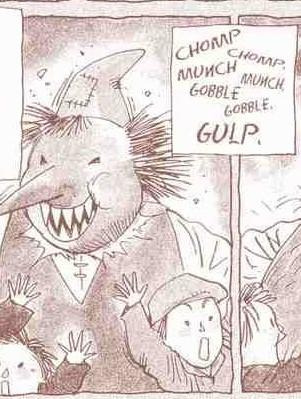
In the tale of the nameless monster, Johan can be both the monster and the boy who has been possessed by a foreign entity. That depends on how you interpret it.
This tale could be an allegory for what is happening to the twins, which are represented as nameless monsters. Johan could not remain himself, all the time hiding under different "faces'', changing names and identities. However, he couldn’t stay in any of them for long. His nature was bursting out, destroying these masks and whatever and whoever was around in the process. Nina on the other hand, even knowing her past, accepted the truth. Accepted her mother's choice and hardships she had to endure. She no longer tries to appear to be someone else, having chosen to move on with her life.
A second interpretation: Johan-the-Prince and our Johan are both weakened boys on a brink of death. For each of them, letting the Monster in, something scary, unnatural to humans, was a way to survive. So our Johan suppressed his sensitivity and susceptibility by pretending to be a not-quite-human, until traces and even references to his humanity have all but disappeared.
I don't think the fairytale manipulated Johan as a child, messing up his consciousness. What’s truly sinister about this picture book is that it foretold his fate.
As an adult, he picks up this book and sees himself in both the monster, who could not bear the present self and took on another's form, and the boy, who in an attempt to survive has ceased to be human, has destroyed everything around him. All that remains is solitude.
Imageries of the prince and the monster merge into one, and in one thing they are similar - in a fear of losing their lives, they lied primarily to themselves, and that lie destroyed the being of each of them. Neither monster nor prince really saved what they were protecting so desperately.
In addition, the book itself was an object from Johan's distant childhood, now almost forgotten, and served also as a reminder of the times when he was an ordinary, normal child.
Johan was wearing masks all the time, but the greatest of all his deceptions was not to live under the names “Johan Liebert”, “Franz Heinau”, “Erich Springer”, or any other for that matter. The most atrocious lie was to wear a mask of the nameless monster, even convincing himrself that this is who he is, that the emptiness and void is all there is to him. Wearing the guise of the nameless monster for years he had almost lost every memory of being human, and the book in his hands was a painful, violent reminder of his cowardly self-deception, his abandoned humanity, his forgotten self.
PART 5: I AM NOT YOU, AND YOU ARE NOT ME
From the moment the book falls into his hands, Johan probably realizes that his worldview is very much distorted. One of his fundamental beliefs about himself has been undermined, so debunking the rest of his illusions becomes a priority.
He remembers orchestrating the massacre at Kinderheim, but his belief that he was always capable of such things is shaken. He suspects that in his lost memories he will find the answer to the question he didn’t even think of asking. If he wasn’t born a monster, how did he become one?
We are not allowed to listen to the entire contents of the tape from Kinderheim 511. Only his attachment to Anna becomes apparent from it; but maybe he proceeds to talk about the Red Rose Mansion next. During interrogation he could recall his sister's words, which he heard again and again after her return. Her story was told in the first person POV: “I saw <....> I heard <…> I was <...> I ran <...>”. On recording he could repeat verbatim the words of his sister, and then, as an adult listening to it, misunderstand the meaning of those words. After all, he heard himself saying “I was taken <...>, I saw people die <...> , I ran away…” And only on the basis of this would he latch on to the story about the Red Rose Mansion as an explanation for what he had become.
Johan then decides to destroy the place. Although he clearly doesn’t recognize it, it doesn’t ring the bell yet.
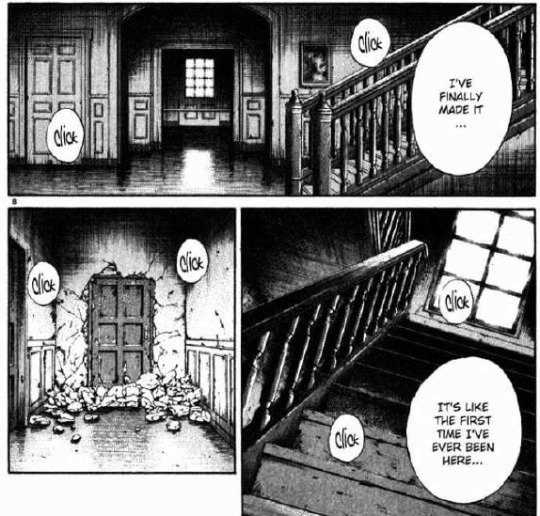

Johan at that moment still considers himself a single set of personalities with his sister, and believes that in his mother's eyes they looked the same.
I can only assume that he told Čapek that Nina would kill him because he mistakenly thought that Nina held the same opinion about their connection as he did. If he's willing to kill for her, she'll do the same. Of course, he was wrong: he saw himself as an extension, a shadow of his sister, taking her joy and pain as his own; Nina, as much as she loved her brother, did not see herself and him as one, and clearly drew boundaries between her being and Johan's.
The capacity to experience oneself as autonomous means that one has really come to realize that one is a separate person from everyone else. No matter how deeply I am committed in joy or suffering to someone else, he is not me, and I am not him.
The assumption of being taken away by Bonaparta and being cast aside by his mother was one of the last crutches guarding him from the horrifying truth - he was the one who turned himself into a monster.
He cries when he hears Nina's story. Realizing that they’re not one, and she has never perceived Johan in this way. She is not his true self, and he is not his sister's false self. He sees more and more clearly the outlines of the true self within him, and he does not like the picture emerging before him at all.
All the “saving” he was doing turned out to be a sham that didn’t bring any of the twins the expected result. He experienced the guilt of denying himself existence and grew so enraged that he decided to kill himself. He now saw his true self - destructive, without a good reason. And realized it had to be eradicated, along with the man, the Monster, who made him that way - Franz Bonaparta.
PART 6: RUHENHEIM
The final stage of Johan's collapse, the massacre at Ruhenheim.
When he gets to Bonaparta's old house and finds numerous sketches of him and his sister as children he understands that Bonaparta was not “a monster outside of him”.
He refers to him as such when meeting Čapek, implying that Franz is to blame for him becoming a murderer. Upon seeing these sketches he recognized that Bonaparta's intentions had changed greatly over the years, and both Anna and himself were able to escape their fate because of his suddenly awakened sympathy. Not that this excuses Bonaparta, he was the one who designed the experiment after all. But these sketches were a confirmation of his kind intentions towards the twins, whatever they may have been at the outset.
It turns out that when Bonaparta came to visit the Lieberts, he was no longer a threat to Johan and Anna. Johan now knew that the night he shot the Lieberts had indeed stumbled and made a fatal mistake which tore him apart from Anna and plunged him deeper into the abyss of despair.
The event that finally convinced him of the animosity of the world and the lack of a safe corner anywhere in it was a figment of his mind which was led by fear.
This discovery was the final straw for Johan. Any image he had of himself collapsed for good.
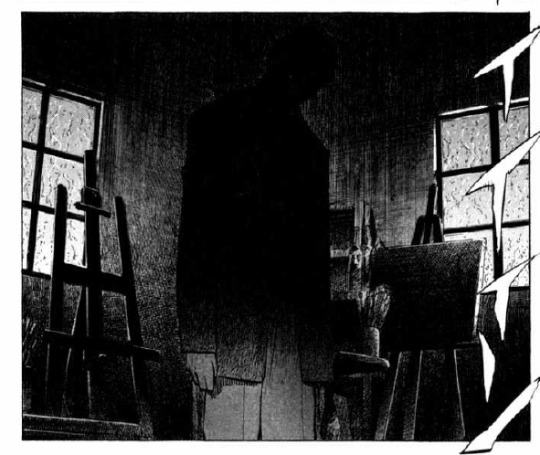
The ending of "Monster" is Johan's realization of the fact that he undoubtedly Is. He exists, he is real, and he is him. And he was among the people who denied him the right to live; he was incapable of standing up for himself and recognizing his right to life, as his sister managed to do. He was so eager to erase any traces of himself from the world that didn’t notice the huge trail of blood dragging behind him, that was solid evidence of his existence, the only thing he had left.
He didn’t need to do horrible things that only left him and Nina traumatised. That left him all alone, miserable, separated from her.
He tried so hard to evade the evil people that he killed his Self before anyone had a chance to lay a hand on it.
When he set out to be nothing, his guilt was not only that he had no right to do all the things that an ordinary person can do, but that he had not the courage to do these things over and against and despite his conscience which sought to tell him that everything he did or could do in this life among other people was wrong. His guilt was in endorsing by his own decision this feeling that he had no right to life, and in denying himself access to the possibilities of this life.
After everything he learned about his past, Johan can’t forgive himself. For throwing himself into oblivion, for locking himself in the darkness. For making himself a monster that he was not born to be, that he had a chance not to become.
He was just as capable and deserving of normal life and real, deep connection with others as any other human being. He just convinced himself that he wasn’t one, and nobody dared to contradict him.
There is a desire in him to preserve not only himself from being consumed, but also those he cares about from himself. He thinks of his love as disastrous - because of it, Anna lost her brother and adoptive parents. Tenma, who saved him, was forced to be on the run for several years after becoming a murder suspect.
If there is anything the schizoid individual is likely to believe in, it is his own destructiveness. He is unable to believe that he can fill his own emptiness without reducing what is there to nothing. He regards his own love and that of others as being as destructive as hatred. To be loved threatens his self; but his love is equally dangerous to anyone else. His isolation is not entirely for his own self's sake. It is also out of concern for others. <…>
…what the schizoid individual feels daily. He says, 'It would not be fair to anyone I might love, to love him.' <…> He descends into a vortex of non-being in order to avoid being, but also to preserve being from himself.
He wishes to die now more than ever - a real death, this time. Not just existential, but total. The true end, as he called it.
Appearing in front of Bonaparta and Tenma, he doesn't aim at Franz, because he no longer blames Bonaparta for what he has become.
Johan said the only thing everyone is equal in is death, and what was behind his words: he says to Tenma that not everyone is worthy of saving, of being loved and forgiven, and Tenma should've finally realized this after meeting him and really knowing him. Because he's a monster, and being cheerful, having hope and light in their life is something that others can have, but he can’t; he's completely out of this human world and the only thing he has in common with everyone else is that they are mortal and so is he.
But even in his death he is mistaken. Once again believing he has no right to exist, he hopes to laugh at the world one last time, and die at the hands of the man who once saved him. After all, he certainly wouldn't have done it, knowing what Johan would grow up to be.
Isn’t that right, Dr. Tenma?…
Nina forgave him and the man who saved his life long time ago doesn’t regret his choice anymore and commits to it. The only people dear to him have recognized his right to live, whatever he may be.
Alas, how this affected him, we don’t know, and all we’re left with is speculation.
As a sentimental person, I want to believe that it meant something to Johan.
But what I really don't doubt is that Johan by the end is a completely different character to the one he used to be. Broken, disarmed, miserable. But it’s finally truly him.
"I think I must have figured out how the show ended. The Magnificent Steiner, he probably, became human again."
PART 7: THE FINAL ESCAPE

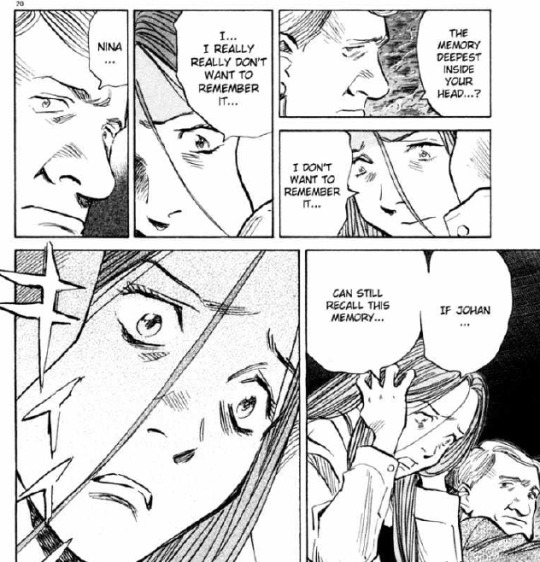
A mother plays a huge role in the development of her children's ontological insecurity - sometimes by being outright dismissive, sometimes by simply enjoying the child's undemanding and calm nature.
Here's what you can read about the mother’s impact in “The Divided Self”, those are Laing's reflections and descriptions of several of his patients.
... we suggest that a necessary component in the development of the self is the experience of oneself as a person under the loving eye of the mother.
His own feeling about his birth was that neither his father nor his mother had wanted him and, indeed, that they had never forgiven him for being born. <…> He was treated as though he wasn't there.' For his part, not only did he feel awkward and obvious, he felt guilty simply at 'being in the world in the first place'. His mother had, it seems, eyes only for herself. She was blind to him. He was not seen.
She had a great deal to say about her mother. She was smothering her, she would not let her live, and she had never wanted her.
Johan’s mother's choice was the first one in the long list of his miseries, it also triggered his ontological insecurity. And how could it not arise when the mother herself abandoned one of her children?
However, Johan was unaware that his mother had thought up names for the two of them, even before he and Nina were born. It turns out that the arrival of the second child was not an unpleasant surprise to her, she was looking forward to having them both.
She had always acknowledged the existence of both her children, and in her eyes they certainly weren’t a one big entity divided by chance into two bodies, one of which was never meant to be there.
But Johan looks truly disturbed after listening to Tenma. And this new revelation could also be another beginning to despair.
There is a door that must not be opened. What lays behind it: a paradise, or another monster?
Tenma, by telling him that the mother had given names to both of them, might have brought Johan down to a new hell. Where the mother recognised the reality of both her children and yet seriously chose which of them to keep.
This sort of thing doesn’t happen in real life, but since it’s fiction we’re talking about, I think we should pay attention to the fact that Johan wakes up only after hearing Tenma’s words. There is a symbolic meaning of him being stuck between life and death for so long.
It’s like he was resisting to be alive again, refusing to stay awake, choosing to be in a coma rather than walk this Earth again. But yet he didn’t die - a part of Johan was holding onto life despite all the horrors it brought to him.
In his last waking moments, he was miserable after discovering all the truth about himself. He really wanted to die, he thought it was the only thing he was deserving of; but Tenma didn’t shot him, his sister forgave him - and it wasn’t the outcome he expected at all. It started an inner conflict he didn’t have the time to resolve.
Johan as well could see the memory of mother’s choice in a different light. By opening up to Tenma he admitted it as a serious enough cause for him to abandon his humanity, as he really was living in a world full of threats. Hiding and pretending came natural to a child that didn’t know any better. And his mother, however hurtful her choice was and how wrong was the very fact of it, loved both of her children, Johan knows that for sure now. Maybe, he could finally forgive himself for becoming a monster. There was no one left to blame for the way he had turned out, no one to take revenge on - even himself.
(I know it can be confusing, so I’ll clarify, just in case - by “forgiving himself” i don't mean he simply dismissed the damage he did to others. He could only forgive the one he, with his own hands, inflicted upon himself, finally realizing, he had no other choice in his circumstances.)
He had a chance to accept that he had the right to exist all along, from the very beginning.
Finally, I want to get into the last excerpt from Laing's book. These are his patient's words from their conversation.
I could only be good if you saw it in me. It was only when I looked at myself through your eyes that I could see anything good. Otherwise, I only saw myself as a starving, annoying brat whom everyone hated and I hated myself for being that way. I wanted to tear out my stomach for being so hungry.
<…> Everyone should be able to look back in their memory and be sure he had a mother who loved him, all of him; even his piss and shit. He should be sure his mother loved him just for being himself; not for what he could do. Otherwise he feels he has no right to exist. He feels he should never have been born. No matter what happens to this person in life, no matter how much he gets hurt, he can always look back to this and feel that he is lovable. He can love himself and he cannot be broken. If he can't fall back on this, he can be broken. You can only be broken if you're already in pieces. As long as my baby-self has never been loved then I was in pieces. By loving me as a baby, you made me whole.
<…> It was terribly hard for me to stop being a schizophrenic. I knew I didn't want to be a Smith (patient’s family name), because then I was nothing but old Professor Smith's granddaughter. I couldn't be sure that I could feel as though I were your child, and I wasn't sure of myself. The only thing I was sure of was being a 'catatonic, paranoid and schizophrenic'. I had seen that written on my chart. That at least had substance and gave me an identity and personality. [What led you to change?] When I was sure that you would let me feel like your child and that you would care for me lovingly. If you could like the real me, then I could too. I could allow myself just to be me and didn't need a title.
I walked back to see the hospital recently, and for a moment I could lose myself in the feeling of the past. In there I could be left alone. The world was going by outside, but I had a whole world inside me. Nobody could get at it and disturb it. For a moment I felt a tremendous longing to be back. It has been so safe and quiet. But then I realized that I can have love and fun in the real world and I started to hate the hospital. I hated the four walls and the feeling of being locked in. I hated the memory of never being really satisfied by my fantasies.
The above passage resembles Johan in many ways: the hunger he felt for real life, the doubt of being loved by mother, the bond which he developed with Tenma…. The last has to be special for Johan: the doctor didn’t simply let him off the hook in the end, he actively chose to save his life.
And just as Laing's patient laments how difficult it was for her to give up the label of "crazy, schizophrenic” because it was the only description she felt could be applied to her, Johan couldn’t part with the mask of the nameless monster for the longest time. It was, after all, the only constant in his life. And now he knows that "nameless" part isn’t really true. Or maybe it doesn't matter anymore. He is just him.
It’s up for a debate whether Johan chose life or death in the end. There’s evidence for both and this ambiguity is sure intentional on the author’s part.
I just want to believe it was a newfound hope that got Johan out of the hospital bed.
#johan liebert#monster anime#naoki urasawa's monster#anime analysis#monster anime analysis#nina fortner#kenzo tenma#naoki urusawa#monster meta
870 notes
·
View notes
Note
something I wanted to understand, the author said that satoru was quite a womanizer, but then he said that geto was much more popular among women than satoru I didn't understand
Technically, the author said that they didn't see Gojo being faithful to one or a certain woman not that he was a womanizer.
With what we know about Gojo (and Gege Akutami's trolling ways, for that matter), I think that's up for interpretation.
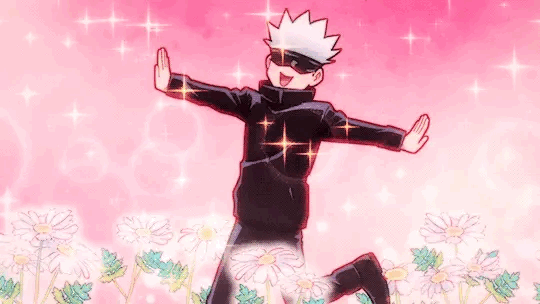
FAN INTERPRETATION
Fans really took that sentiment and kind of ran with it because, to us, Gojo is high spec in every way. Canonically good looking, tall, competent at like.. everything according to Akutami, strong and presumably loaded. Of course someone like that would be a womanizer, right?
Except Gojo is an oversized child who still kinda refers to Digimon in conversation and primarily hangs out with 16 year olds. People project a lot of their BS onto him because they can't imagine ticking all those boxes and not being an asshole. But he’s a corny dork who is seemingly impervious to the outright disdain of most of the people around him. IT’S COMICAL. Personally, I think this interpretation is incorrect, demonstrably.
The other side of the fandom is naturally like... well of course he couldn't stay faithful to one woman. He's been faithful to Geto for ten years! I think we know what camp I've pitched my tent in *gestures vaguely to the rest of my blog* Especially when you bear in mind that Gege Akutami specifically designed Gojo and Geto to be intrinsic complements of one another.
CANON
I'm not so SatoSugu addled (once the brain rot sets in, it's terminal) that I am unable to disclose the secret third way we can interpret this. Canonically, when we look at Gojo as a character... it almost makes sense to assume he's simply not interested in dating at all.
Empirically finds it hard to relate to others
Even when he does care for others, he's still emotionally shallow and aware of it
Gojo clan leader with all associated unpleasantries and responsibilities from a young age
Single benefactor to two children; assumes direct responsibility over two more by staving off their execution
First line of defense for all of jujutsu society
Has a grand design of toppling said jujutsu society
Has experienced devastating loss which informs the grand design of his life's mission and he's always plotting, even when it comes to the seemingly altruistic act of "adopting" the Fushiguro kids or pressing Yuta and Yuji to learn under his care. When you consider that context, it furthers the idea that he's pretty divorced from emotion. Like, he wants them to have a childhood but its still at the pleasure of his convenience and ultimate purpose.

LOOK at this gorgeous, gorgeous boy from pop layer art because I need it and, when I covet, you must also covet. Edit: I'd accidently copied the wrong link there! It's been fixed 💙
In universe, we've seen maybe two canonical couples: Yuta & Rika and Hakari & Kirara (to be animated). This supports the fact that Gege's not really concerned with injecting "romance" into the plot unnecessarily. Undeniably and supporting the SatoSugu agenda, however, is the fact that JJK 0 very much aligned Gojo & Geto with Yuta & Rika with the theme coming to a head in season 2 with Gojo's sealment. For clarity, I mean how love ultimately cursed Rika and Geto after death by Yuta's begging her not to leave and Gojo not properly disposing of Geto's body. Love turned Rika into a curse and allowed Kenjaku to swoop in on Geto.
GETO'S POPULARITY
Geto is, quite literally, popular with everyone in universe and that was before he became a cult leader... which also indicates a predilection for popularity, I guess? As a character, he is principled, thoughtful, gentle and strong. I think, collectively, we tend to toil over the fact that Gojo spent more time missing Geto than he actually knew him. But... that's the same for Shoko and Nanami. After Geto's defection, Nanami couldn't forsake him even if he morally couldn't approve of his actions. Over ten years later as the night parade of a hundred demons is set to take place, Yaga starts saying something along the lines of finally getting rid of the scourge that is Suguru Geto and Shoko makes it a point to leave. I think it's because, after everything, she still holds affection and pity for Geto and would rather not hear him being bad-mouthed for breaking under the pressure of things.
He was the best of them, after all.
#neon asks#anon asks#we are the strongest#stsg#satosugu#gojo#gojo satoru#satoru gojo#anime#manga#jjk#jujutsu kaisen#jjk meta#jjk character analysis#head canon#character analysis#anime analysis#gojo analysis#geto suguru#suguru geto#satosugu brainrot#jjk brainrot#jjk headcanons
130 notes
·
View notes
Text
Twisted Tropes: An Examination of How Magical Girl Tropes are Subverted in Puella Magi Madoka Magica
(this is a long one, clocking in at over 1600 words. Enjoy!)
Madoka Magica has often been called a “deconstruction” of the magical girl genre, and while many fans refute that claim, it’s clear that it at least offers a darker twist on many of the tropes beloved and well-known in the genre. These tropes include the transformation trinket, the cuddly mascot, the monster of the week, magical girls having a secret double life, magical girls themselves being child heroines, and even the concept of why magical girls fight in the first place.
One of the biggest examples of these tropes being twisted is the magical girl transformation trinket, which in this series are Soul Gems. In more conventional magical girl series, transformation items are pretty, flashy items that enable the girl to transform from her civilian form to her magical girl form- and to be frank, serve the double purpose of selling toys and merchandise in the real world.
In PMMM, Soul Gems are beautiful Faberge egg-like items that serve the same purpose. It turns out though, that their name is very literal; they are gems that serve as containers for the magical girl’s soul (or may even be her crystallized soul, it’s not really made clear). Soul Gems are formed when magical girls make a contract with Kyubey and are the source of their powers. Moreover, because her soul has been ripped out of a magical girl’s body, her body cannot function unless her Soul Gem is within a few hundred feet of what is now her soulless husk.
In more traditional magical girl shows, transformation trinkets sometimes get stolen, misplaced, etc with no ill effect for their users except for an inability to transform. In PMMM, this is a literal death sentence unless the Soul Gem can be recovered (as displayed in episode 6, when Madoka tosses away Sayaka’s Soul Gem in an attempt to prevent her and Kyoko from fighting). The consequences of this are actually explored in one of the routes of the Madoka Magica PSP game; Sayaka is separated from her Soul Gem in a Witch’s barrier, and it takes Kyoko days to find it. In that amount of time, her body began to literally rot.
The next concept I want to explore is that of the cuddly mascot. Magical girl mascots are a common feature in many shows, from the Moon Cats in Sailor Moon to Cerberus in Cardcaptor Sakura to the many, many mascots in the Precure franchise. In all of these series, the mascots act as friends and often mentors to their magical girl companions; in most series, they are also responsible for empowering/awakening their magical girls.
In PMMM, Kyubey initially seems to be much the same. He is a cute, cuddly creature who is responsible for creating and guiding magical girls. Pretty soon however, it becomes clear that Kyubey is a sinister figure. His contracts don’t seem very benevolent; they seem exploitative, taking advantage of girls when they’re at their lowest point. And unlike the Senshi in Sailor Moon or the Cures in Precure, it quickly becomes apparent that the magical girls in PMMM are dealing with much higher stakes- at least, when it comes to their own wellbeing.
PMMM almost seems to ask the question: what kind of creature would give superpowers to children and send them to fight monsters that could very easily kill them? Even Kyubey’s appearance is highly implied to be a carefully calculated façade meant to lure teenage girls into a false sense of security and make them feel drawn to him. For example, Kyubey uses this to his advantage when he plays up his helplessness to Madoka in episode 1 when he’s being hunted down by Homura. In reality, the Incubator’s true appearance- as seen in Rebellion- are implied to be mechanical structures with giant eyes in the middle; a very alien appearance suiting their alien origins and psychology.
Speaking of child heroines, PMMM also addresses the magical girl tropes of the child heroine and the double life. In most magical girl shows, being a teenaged (or even child/preteen) magical girl is portrayed as an exciting, glamorous, heroic position. The role of magical girl is often contrasted against the mundane, yet still charming and school and civilian life. Magical girls often work hard to maintain the secret of their alter egos from their (non-magical girl) friends and family, although in some series the secret does come to light. However, the girls are usually able to enjoy a healthy balance between their personas.
In PMMM, magical girls seem more like child soldiers than glamorous heroines. Being young girls and not hardened adults, many magical girls face severe psychological trauma from the life they’re thrust into- much life real-life child soldiers. Most magical girls made their contracts without truly getting to think about their wish or the consequences of being a magical girl for the rest of their lives. And because getting enough Grief Seeds is literally life-or-death, they must spend most of their free time patrolling for Witches.
We get a good look at the toll being a magical girl takes on one’s social life through Mami’s character; supplementary materials reveal that she was once a popular girl who had a lot of friends, but after she was forced to contract in the same accident that killed her parents, she slowly lost all her friends because she had no time to do anything else but train, hunt Witches, fight Witches, etc in her free time. In episode 3, when Madoka talks about how she wants to be a magical girl, Mami outright tells her that the life of a magical girl is a lonely one and Madoka will no longer have time for things like boys or hanging out with her friends after school. Even in Magia Record- an alternate timeline that offers a much more positive look at the PMMM-verse- most magical girls are only friends with each other.
Another major example of a trope being twisted is that of the “monster of the week.” Most magical girl series have the girls fight monsters, and in many of those series the monsters are created from human beings. Sailor Moon and the Precure franchise are two standout examples of this. For example, in the fifth season of the 90s anime adaptation of Sailor Moon, people who don’t have “true” Star Seeds will turn into monsters called Phages if their Star Seeds (ie, souls) are ripped out. A similar phenomenon happens in Heartcatch Precure, with the added bonus of the victim’s consciousness eternally reliving the same state of despair that made them vulnerable in the first place. In all of these series, however, the magical girls are able to heal the victims and restore them to their former selves. Sometimes, if the monster/victim is a loved one or someone else known to them, they can even do a “I know you’re in there somewhere” plea to help them to break free.
PMMM takes the true horror of this concept up to eleven. Moreover, the victims aren’t regular people- they’re the magical girls themselves, and this fate is inevitable. Every magical girl, if she doesn’t die in battle against a Witch, will become a Witch herself who spreads despair and kills innocent people until the day she is put out of her misery by another magical girl. And she will be in misery; the Rebellion movie shows that Witches relive the worst moments of their lives over and over again and are psychologically tortured. A lot of Witches also seem to be in ironic hells. For example, Charlotte can create any dessert she wants except for cheese or cheesecakes, which is her favorite food. Roberta is surrounded by lascivious men (her familiars) who annoy her. And of course, every Witch was once a magical girl who once spread hope and saved people and now does the opposite.
It’s also made abundantly clear that once the Witch transformation happens, it’s over. There’s no saving someone. The only person in canon who is able to actually get results is Madoka- aka an actual goddess with huge karmic potential- and it comes with caveats (in one, later timeline she brings Sayaka back from the dead after she became Oktavia, and in Rebellion she is able to reverse Homura’s transformation into Homulilly- although afterwards Homura still needs to be brought into the Law of Cycles like any other magical girl about to become a Witch). In episode 9, when Kyoko and Madoka try to reach out to Sayaka’s inner self when Kyoko fights Oktavia, it ends in Kyoko’s death because nothing of Sayaka remains.
In most magical girl shows, the monsters of the week are just ineffectual mooks who are fodder for the evil organization opposing the magical girls. But in PMMM, they are mirrors of the magical girls themselves, agents of chaos and despair who present a very real threat to the magical girl’s lives- not to mention the lives of any unfortunate people who stumble across them.
Finally, I want to examine the topic of why magical girls fight in the first place. In most series, there is a group of villains who pose a threat to humanity/the Earth/etc and magical girls must oppose them. There is a very real external threat being faced.
In PMMM however, the beings that empower/perpetuate magical girls and are ultimately the threat are one and the same. Because the tragedy of PMMM is that magical girls are fighting against a self-perpetuating cycle; magical girls form contracts, magical girls become Witches, more magical girls form contracts and fight the Witches, and on and on it goes. Magical girls are their own enemy, in a sense.
I’m sure there are lots of tropes I’m forgetting, but this essay is already over 1,600 words long, lol. I might make a part 2 at some point, so give me your ideas!
#I wrote this while I was stuck at the office this week lmao#it helped keep me sane#pmmm#puella magi madoka magica#madoka magica#analysis#my analysis#my writing#anime analysis#tropes#writing tropes#magical girl#magical girls
397 notes
·
View notes
Text
Shiguang Dailiren/Link Click
Hanakotoba Analysis

Cheng Xiaoshi/Toki -> Daisy (Bellis)
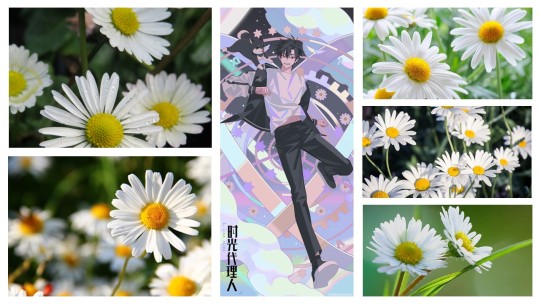
Cheng Xiaoshi/Toki’s official flower is the Daisy (Bellis) as pictured on his official birthday artwork. Daisies are known as chú jú (雏菊) in Chinese and hinagiku (雛菊) in Japanese. This flower is associated with the meanings of “innocence”, “devotion”, “justice”, “charity” and “beauty” in English floriography. Its hanakotoba meanings are “peace”, “hope”, “beauty” and “chastity”. In Japanese culture, daisies are also often associated with new beginnings and are thought to bring joy and happiness to those whom it is gifted. In China, the flower is mainly associated with innocence, purity, hope, and new beginnings. Additionally, they can symbolize simplicity, sincerity, springtime, happiness, and new love.
Cheng Xiaoshi is best described as someone with a good heart whose playful, stubborn and impulsive nature can be interpreted by others as being childish and irresponsible. He is extremely sensitive and deeply empathetic with a strong sense of justice. These characteristics paired with his impulsiveness often not only lead to him making decisions with his heart rather than his head—landing not only himself but also those around him in a myriad of tricky situations—but also result in him doing things that are in the best interest of others but are detrimental to himself. These traits tie into the flower’s meanings of justice, charity and devotion. His seemingly boundless optimism and upbeat personality complement the flower’s meanings of joy, happiness, and springtime. When Lu Guang was asked by Qiao Ling, what attracted him to Cheng Xiaoshi, he stated that it was the other’s naivety. This ties into the flower’s meanings of innocence, sincerity, purity and simplicity.
Cheng Xiaoshi has the ability to enter the time of any photo by possessing the body of the person who took the photo. Using this ability, he is able to directly change the events within a 12-hour timeline of the photo (i.e., alter past events). This ties into the daisy’s meanings of new beginnings and hope. Additionally, when using this ability, Cheng Xiaoshi’s eyes turn gold-yellow which corresponds with the yellow-centre of the daisy.
Lu Guang/Hikaru -> Forget-me-not

Lu Guang/Hikaru’s official flower is the forget-me-not as pictured on his official birthday artwork. The forget-me-not (Myosotis) is known as wù wàng wǒ (勿忘我) in Chinese and wasurenagusa (勿忘草) in Japanese. As its name suggests the flower is associated with the meanings of “true love” and “memories” in English floriography. Its Japanese name means “don’t forget me” thus associating the flower with its hanakotoba meanings of “true love” and “remembrance”. In China, the flower is associated with not only true love and memories but also fidelity and faithfulness.
Lu Guang is typically calm, patient, responsible and uptight. Although not always blatantly obvious, Lu Guang cares deeply for his friends and always does things that are in their best interest. Although typically stoic and cautious, when those important to Lu Guang are in danger, he will break his usual calm façade and show anger and concern as well as pull off precarious manoeuvres to save them. These traits tie into the flower’s meanings of faithfulness and fidelity.
Lu Guang has the ability to see everything that happens within a 12-hour timeframe after a photo has been taken. Photographs are able to capture important moments with loved ones in order to be preserved and looked back upon at a later date. Lu Guang
and Cheng Xiaoshi’s abilities rely on photographs and are used to analyse and manipulate memories, respectively. This further links Lu Guang to the forget-me-not flower. Additionally, when using their respective abilities Lu Guang’s eyes turn ice-blue whereas Cheng Xiaoshi’s turn gold-yellow which corresponds with the yellow-centred, blue blossoms of the forget-me-not, respectively.
Click here for further analysis of Lu Guang given new information from season 2.
Qiao Ling/Rin -> Hyacinth

Qiao Ling/Rin’s official flower is the hyacinth as pictured on her official birthday artwork. The hyacinth (Hyacinthus) is known as fēng xìn zǐ (风信子) in Chinese and haiashinsu (ヒヤシンス) in Japanese. The hyacinth is seen as a symbol of sophistication, refinement, grace and elegance in English floriography. It is also known as a symbol of love and passion. It is also sometimes associated with rashness, games and rebirth. Its hanakotoba meanings are friendship, affection and “love beyond sorrow”. The bright colours of hyacinths are said to represent joy and happiness―and is thus seen as a gesture of goodwill when gifted to others in Japanese culture. In China, the flower is associated with good luck and fortune and is thus often used during special occasions and celebrations as an auspicious decoration. It is said that the hyacinth’s bright colours and cheerful blossoms bring prosperity and good luck to those who see it.
Qiao Ling is best described as outspoken, expressive, and compassionate. She deeply trusts those she is close to and is very protective over them. Qiao Ling typically possesses a playful and upbeat personality. These traits tie into the hyacinth’s meanings of joy, passion, friendship and goodwill. Although often seen bickering with Cheng Xiaoshi―she retains an air of gracefulness and ladylikeness and often dresses very stylishly, which fits in with the flower’s meanings of elegance, grace and sophistication.
Official Art Celebrating 400 Million Views

In this official art the flower bouquet that Cheng Xiaoshi is holding might be his official flower the daisy (Bellis) but could also be camomile flowers. Camomile also known as chamomile is a daisy-like plant in the same family as the Bellis genus (Asteraceae family). Camomile is known as yáng gān jú (洋甘菊) in Chinese and kamomīru (カモミール) in Japanese.
In English floriography, the flower represents the concepts of having “patience in adversity” and “energy in adversity”. In hanakotoba, the flower conveys the meanings of “enduring adversity” and the “power to be born in adversity”. Both the English and Japanese meanings derive from the fact that camomile grows like a creeper on the ground and persists even if trampled on―even growing stronger the more it is stepped on. These meanings greatly complement Cheng Xiaoshi’s immense optimism, endurance, and perseverance that persists despite him being faced with difficult circumstances and harsh obstacles.

In this official artwork, Lu Guang isn’t pictured with his official flower, the forget-me-not but is instead pictured with a bouquet of statice. Statice (Limonium) is also known as sea lavender and marsh rosemary despite not being related to either lavender or rosemary. Statice is known as bǔxuè cǎo shǔ (补血草属) in Chinese and sutāchisu (スターチス) in Japanese.
Similarly, to forget-me-nots, this flower is associated with memory and remembrance. In English floriography, this flower represents “longing”, “remembrance”, “success” and “sympathy”. Purple statice in particular represents suppleness and elegance. The hanakotoba meanings associated with statice are “unchanging heart” and “uninterrupted memory”. The vibrant colour of these flowers does not fade even when dried. This attribute has resulted in its hanakotoba meanings “unchanging heart”, “uninterrupted memory”, and “eternal immutability”. These meanings are similar to that of the forget-me-not and consequently complement Lu Guang’s character in a similar manner.
[If you liked this post, check out my other hanakotoba analysis posts here ❀ There are 2 other hanakotoba posts on Link Click on my blog...]
[P.S. If anyone knows which two flowers are in the very first image in this post (i.e., the season 2 key visual), please let me know so I can add them...I couldn't figure it out for the life of me. Also, if I've gotten any of the kanji, romaji, hanzi or pinyin incorrect, feel free to correct me]
#link click#link click season 2#shiguang daili ren#shiguang dailiren#shi guang dai li ren#shiguang#cheng xiaoshi#lu guang#qiao ling#hanakotoba#hanakotoba post#floriography#flower meanings#link click hanakotoba#link click symbolism#anime#donghua#anime symbolism#donghua symbolism#anime analysis#link click official art
115 notes
·
View notes
Text
I was re reading Law’s backstory to find some embroidery panels to do and I found some things I missed out on during my first time reading it years ago,
I’m going to start with happy, and end with tragic.
First off! - I love this panel but never realized the ones after it showed him just dumping Law onto the ground out of excitement for Law funnily enough.

[ spinning . . !]
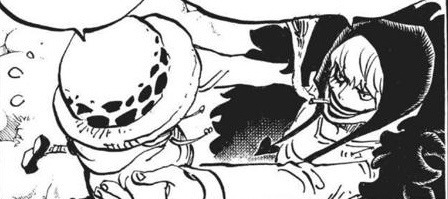
[ spinning . . . ]
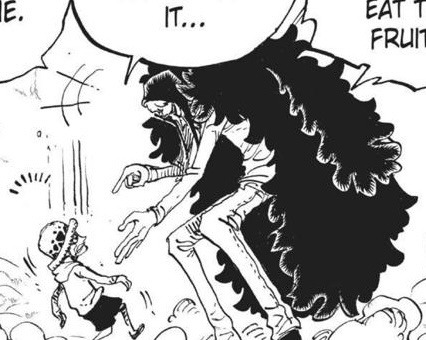
[ lmfao get dropped punk ]

SECOND OFF!!~
Law’s shirt literally reads “amazed✨”.

He acts like his age; unimpressed outwardly but secretly does seem to enjoy the magic tricks, even if he’s “too old for it.”
However…
It’s interesting this panel comes right before these
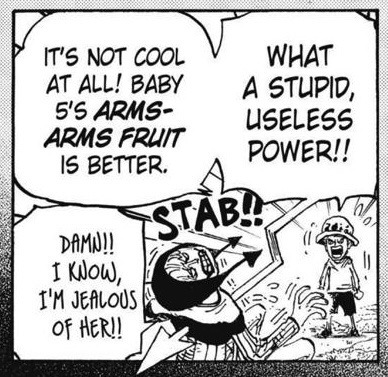
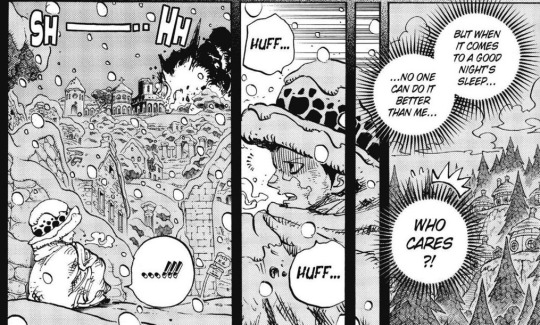
Perhaps this is meant to show regret. Regret for such judgement, or simply wishing for that time, maybe to do over… who knows.
THIRD OF ALL
the change in his eyes is clear when comparing these panels,

Cora knew..
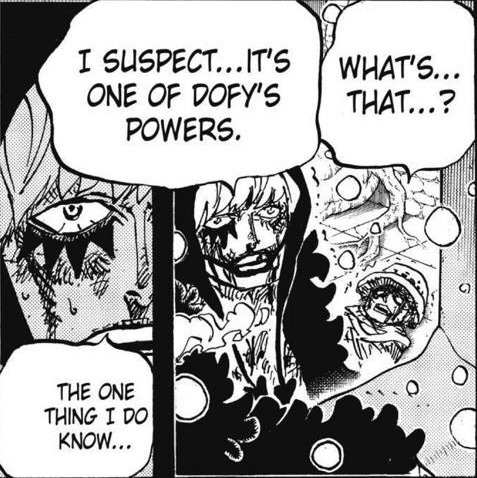
That this was the final curtain.
I believe deep down, he knew this was a final act, but simply wished to not scare him. The love is apparent, and you can see a change across his tired eyes. He doesn’t need one other soul lost, nor Law’s poor soul blaming himself.
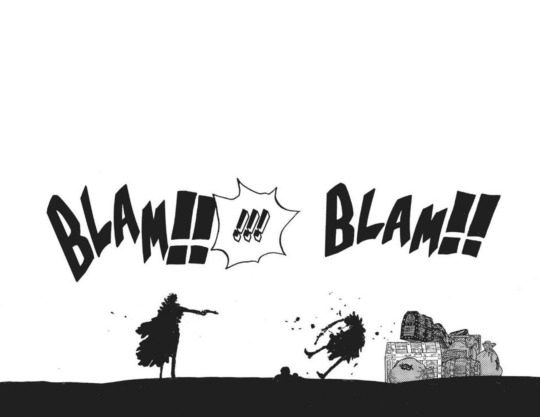
#I’ll maybe post more like this if wanted#I love rereading stuff#and such#one piece#Dressrosa#Trafalgar law#donquixote rosinante#donquixote corazon#donquixote doflamingo#doffy#one piece manga#as I read I guess#one piece analysis#anime analysis
349 notes
·
View notes
Text
trying to articulate how THE most important and special episode/chapter of saiki k is prefacing the end, in which we first see saiki fight the volcano. to get the obvious out of the way first i LOVE how there's an in-universe reason for time not progressing. i was wondering when they'd address the fact that saiki had been an 11th grader for four years and it was so rewarding when they finally did.
but that's not all this episode added to the story. i actually gasped when i realized what the title was. i mean like. think about it. how many episodic sitcoms will go out of their way to establish an end condition? from this episode forward, we know the show will end and we know exactly when it will end: when saiki stops the volcano. before that, we as the audience were comfortably settled into the time loop ourselves, fully willing to accept that these characters would never grow up and would just keep having lighthearted misadventures forever. this episode says no. that can't happen.
because tdlosk is not a static show. the characters, saiki especially, are constantly changing, even if they are stuck in a loop. it was always inevitable that they would move forward, just like we all have to in real life. that's what makes the series ending so bittersweet, and it's perfectly set up with prefacing the end.
#i want to watch a full twenty minute video essay about this#saiki k#saiki kusuo#tdlosk#saiki kusuo no psi nan#anime#manga#analysis#text post#meta analysis#meta#sitcoms#anime analysis#don't let this flop
251 notes
·
View notes
Text
Let's talk about Kyubey
I think Kyubey's a very interesting being. Is he a hivemind or are they separate beings that act and think the same way?
If he is, death for him is just a momentary pain, he has more bodies. If they are separate beings, then death is unimportant for them in the big scheme of things, anyone can take up the job the dead one was doing. They don't know what sadness or fear are, they don't form emotional bonds with eachother. They have one job, and their goal is to do it as efficiently and effectively as possible, guided by their pure logic and nonexistent emotional comprehension.
He's a deceiving little bitch that treats even himself as a tool for a greater good (you know, stopping the universe from extinguishing is a very solid greater good). If he just took a less harmful method of solving the problem, he wouldn't come off as evil, but he won't hinder effectivity over something he doesn't understand.
I think it's interesting to see him as the representation of a way of thinking, that is, people should be willing to suffer for a greater good. In this world, there's many people who agree with this and then make people suffer for what they think it's good. And even it was something all the world views as a greater good, who are we choosing to be the sufferers? How many? How big is the problem in comparison? Is there another way things could be done? If the goal is a more peaceful world, why does the process have to hurt people? How can we show people who don't really get emotions or who are not that empathetic why making others suffer is wrong?
I really loved this character.
#text post#pmmm#puella magi madoka magica#mahou shoujo madoka magica#madoka magica#kyubey#anime#anime analysis#character analysis#fictional characters#anime character
48 notes
·
View notes
Text
Ok, I need to talk about this moment.

Because Gojo pauses. I don't mean how he pulls his hand back. I mean he gets ready, and then he takes a moment to take a breath and try to steady himself. He's trying desperately to convince himself that he can carry out his mission, that he can do what he's supposed to do and eliminate this curse user who murdered an entire village. He's the only one who can do it and it's his job. It's not a matter of whether or not he wants to; he has to.
But of course, he can't. That "curse user" is still his best friend, the only person in the world who it seems got him, and now that friend has just admitted he did all the things he's accused of, and he's going to find a way to do more atrocities, and he's walking away from the world the two of them walked in together.
Geto doesn't ask Gojo to come with him. He doesn't even ask for forgiveness or understanding. The only thing he does is try to absolve Gojo of any guilt he might feel for killing him, and turn his back to suggest that, if Gojo wants to kill him, then he won't even fight back.
And for just a moment, Gojo thinks he can accept it all. He can accept the task given to him by the authorities. He can accept that Geto has become a monster who must be destroyed. He can accept that his best friend just told him it would be fine if Gojo murdered him there in the street to save the lives of so many that Geto no longer sees as worth saving.
But then the moment passes. The willpower to go through with it was only ever a brittle facsimile, and Gojo's attempt to harden it into something actionable has no real effect.
He's forced to withdraw his hand. He can't do it. Not because he lacks the ability. Not because of the possible casualties or the complications of performing such an action in public. He withdraws because, for Gojo, there's only one other person in the world who matters, and no amount of orders or faults or forgiveness can bring him to kill his best friend.
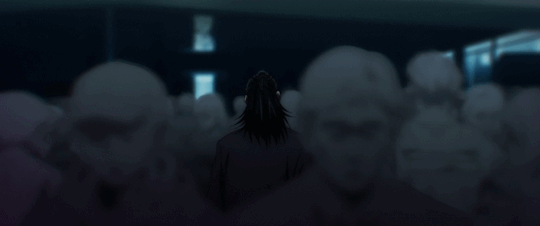

#in that moment he was just a teenager losing his best friend#satosugu#gojo satoru#geto suguru#jujutsu kaisen#jjk season 2#anime analysis#character analysis#pancake thoughts
181 notes
·
View notes
Text
I know in the order of events we’re shown, it looks like Satoru went to find Megumi after Suguru left, but to me, that doesn’t make sense. Suguru didn’t leave until a year after the Star Plasma incident. Why would Satoru wait that long to go find Megumi? It doesn’t make sense.
So, in my head, Satoru went to find Megumi so that he and Suguru could look after him. Think about it.
Megumi’s cursed technique involves using Shikigami, and Suguru’s involves using Curses.
What if he figured Suguru could help develop Megumi’s technique since their processes are so similar?
He also may have seen Megumi as a sort of ‘replacement’ for Riko. Suguru wanted to take care of Riko. That’s evident in the smile he gives her as she’s pouring her heart out to him before Toji arrived.
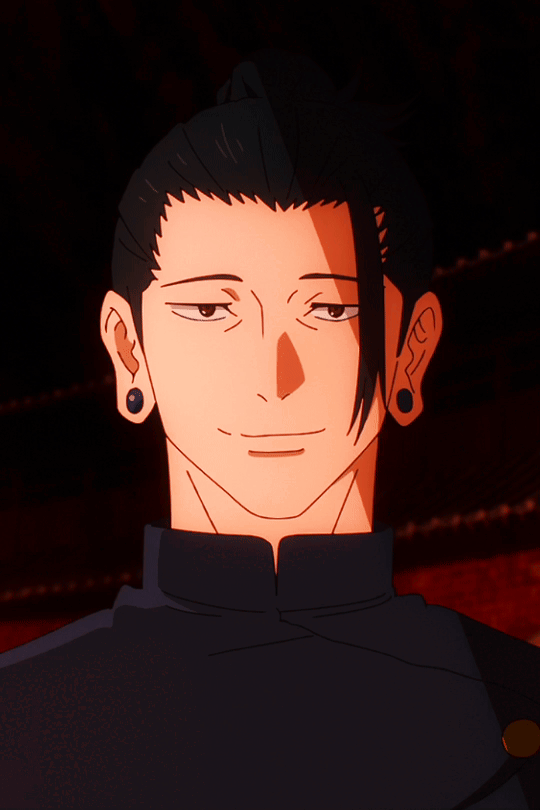
In Satoru’s head (he doesn’t always understand/regard social cues, so even though this thought process isn’t entirely ethical, I think it’s realistic for his character), if he brought this kid back with him for Suguru to take care of and protect with him, like they’d decided to do for Riko, maybe his old self would come back. They would return to normal.
Conversely, I believe it upset Suguru that Satoru brought Megumi back with him. Megumi was a living reminder of the man who tore their lives apart. At this stage, Suguru was already suffering mentally, and to see Satoru so easily “forget” what happened undermined the trust he had in him.
That pushed him to see a bigger rift between them. Satoru made that decision all alone, when they used to run everything by each other. (They’d even constantly be on the phone if they weren’t near each other, something that ceased after the Toji incident. Big life decisions were a dual effort, a collaboration), so that showed Suguru that Satoru was putting barriers between them. Subconsciously saying “I don’t need you to make decisions anymore”, something that he definitely used to believe with his whole heart.
And while Suguru served as Satoru’s moral compass, Satoru served as Suguru’s will to keep fighting. Satoru needed Suguru, and Suguru needed to be needed by Satoru.
When Satoru began acting on his own without Suguru, the latter lost his will to keep fighting.
#more musings#satosugu headcanons#jjk headcanons#jujutsu kaisen#jjk#gojo satoru#geto suguru#satosugu#suguru geto#satoru gojo#stsg#jujukai#jjk spoilers#satosugu headcannon#anime analysis#jujutsu kaisen analysis#jjk analysis
101 notes
·
View notes
Text
Kill la kill: What is Ryuko and Senketsu's friendship anyway
I talked before about how Life Fibers are representations of fate and predominantly facist ideals, which is why the show ultimately isn't about and doesn't end with interspecies friendship. Senketsu then is a representation of Ryuko's fate, and in the end, he frees Ryuko of himself.
BUT, Ryuko and Senketsu's relationship is more complicated than "fate imposed on a person"...... yet at the same time that's exactly what it is. Their friendship is real and fraught with ups and downs, and they BOTH undergo arcs catalyzed by the other.
Ryuko is a product of destiny grappling with her own agency. She takes up the scissor blade in order to avenge her dad, but was forced to confront her fate--Senketsu, who was tailor-made specifically for Ryuko, and who very literally and uncomfortably forced himself on Ryuko.
...Not a great start tbh. Just as Junketsu is Satsuki's wedding dress, Senketsu is Ryuko's. At that point, the only reason Ryuko rolled with Senketsu was because she could then leverage Senketsu's powers to defeat Satsuki.
(Side note, Satsuki forces Junketsu to bend to her will, but like her conquest, playing to best the system is still playing within the system. Both girls were both going to be fed to their predetermined fates one way or another. But anyway)
Ryuko has a complicated relationship with her destiny and with herself, all of which is reflected in her friendship with Senketsu. She was forced into a role, became a pawn in a game set by her parents and those around her, and yet somehow learned self love and agency. Her relationship with Senketsu is a reflection of her own self-image: when she's comfortable in her own skin, she and Senketsu are in harmony. When she is disgusted by the truth of being a Life Fiber human hybrid, she sees herself in what Senketsu is, and is vehemently repulsed.
Like Ryuko, Senketsu is a hybrid of Life Fibers, Ryuko's human DNA and his own personality. As much as Ryuko is a product with predetermined destinies, so is Senketsu, more obviously even.
Senketsu is weaponized clothing. In a world where everyone wanted to possess or destroy him, Ryuko calls him her friend.
Ryuko is a manufactured hybrid soldier. In a world where everyone wanted to use her or put her down, Senketsu calls her his friend. (We'll get to Mako in a bit)
Senketsu and Ryuko both embody their own struggles against fate and self-image. How can you live and accept yourself, when you were created a monster? A tool to be used and otherwise euthanized? Products made to either save or destroy your own species?
"Everyone else can take off their clothes, but I can't take off my own skin."
Although Senketsu's struggles aren't as upfront as Ryuko's, we still see him grapple with how Ryuko perceives him: as a friend, as "just a piece of clothing," as a mirror held up to herself? And what then, when the answer is "yes?"
The simple and most difficult answer, that I believe was presented to us, is to accept yourself and to choose what path to walk.... which is essentially the very thing that our facist villain Ragyo wants to eliminate.
At her lowest point, Ryuko was faced with the reality that she is in fact the weapon that everyone treated her as. Her fears are realized. How can anyone love this? How can she? Mako shows her that there are those who love her unconditionally--Mako herself in fact! It's important that Ryuko realizes this. But this alone isn't enough to save Ryuko from self-loathing.
The Wedding is a scene where we can clearly see the difference between giving into a predestined fate, and accepting yourself. It's here that Ryuko finally realizes that she does have the power to choose, and that for everything she is, she is unconditionally worthy of love from others and herself.
Senketsu would also make this realization, but from his side of the coin. He is clothing, to be worn, to be grown out of. He is also a weapon destined to consume his wearer. He is horrified by the idea that Ryuko is supposed to be his food, and yet would force himself onto her at the beginning. Even at the time of the Wedding, Senketsu declared that he'd force Ryuko to wear him to save her.
However, like Ryuko, Senketsu struggles with and would finally accept Ryuko's own agency. Ryuko broke out of the Wedding NOT because she was forced to wear Senketsu, another wedding dress, but because she CHOOSES to. It is finally when she willingly and full heartedly accepts herself that she and Senketsu are the most powerful, and this could only happen by her choice.
Notably, Ryuko flays herself of Junketsu, effectively a second skin, to be in her own skin again.
Just as Ryuko is a person who can choose what to wear, Senketsu is clothing that is chosen to be worn.
That's not to detract from Senketsu's personhood. What I'm saying is that Senketsu is clothing given voice and personality, and both he and Ryuko learn to make peace with what they are, and are empowered by the choices they can make.
People are people. Clothes are clothes.
People are not meant to be worn, clothes are.
This is why Senketsu leaving in the end is a powerful conclusion to his and Ryuko's arcs. Even as he burns, he protects Ryuko. He tells her to wear something she wants. As much as they could've been destined to meet, as much as he is Life Fibers meant to consume her, he is not her wedding dress, and nor will he force her to wear him. He is clothing but chooses to be a friend.
We are what we are and can't change how we were born; perhaps that is fate. But our choices are what really matter, and some of the most powerful choices we can make are to accept and love ourselves.
#do you guys know i really like this battle bikini anime#head in hands shinji chair#kill la kill#kill la kill thoughts#analysis#ryuko matoi#satsuki kiryuin#mako mankanshoku#Senketsu#not art#anime analysis
101 notes
·
View notes